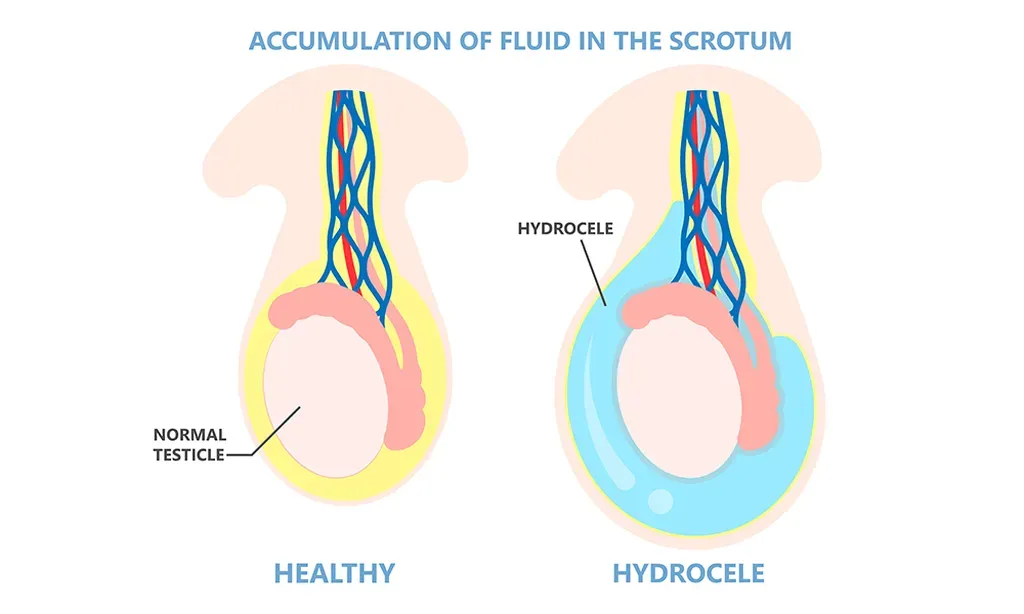A hydrocele is scrotal swelling that develops when fluid builds up in the thin casing surrounding your testicle. It’s common in newborns, usually resolving without treatment before the baby is a year old.
The swelling is rarely painful, but adults could experience some discomfort if their swollen scrotum is heavy. It might become painful as it gets bigger and inflammation increases. You might find the swollen area gets larger throughout the day. However, anytime that you have swelling in the scrotum, it’s important to see a board certified urologist to make sure that it’s not a symptom of testicular cancer or other conditions impacting the scrotum such as variocele or spermatocele.
Fortunately, it doesn’t affect your fertility and is unlikely to harm you. Although, it’s sometimes a sign of an underlying condition that can cause severe problems. One problem is infections and tumors that affect sperm production and quality. Another is an inguinal hernia, where part of your intestine gets trapped in the abdominal tissues. Hernias can lead to life-threatening complications.
This swelling of the scrotum occurs when the thin sac that surrounds the testicles fills with fluid. Hydroceles are common in newborns and usually go away without treatment by the time they celebrate their first birthday. However, older children and adults can also develop a hydrocele due to an injury or other underlying medical conditions.
Causes of hydrocele are not always clear, but some cases may be due to an infection, inflammation, injury, or tumor of the testicle. Swelling in the scrotum may also be a sign of testicular cancer or an inguinal hernia, so seeing a urologist right away is essential for a proper diagnosis. While hydroceles are generally painless, they can cause discomfort or heaviness in the scrotum. Treatment may be necessary if the hydrocele grows large or causes discomfort, and options include surgery or draining the fluid with a needle.
If you or someone you know is experiencing symptoms of a hydrocele, it is important to seek medical attention to determine the underlying cause and appropriate treatment. With proper care and management, hydroceles can be effectively treated and managed to prevent complications and improve quality of life.
Types of Hydroceles
There are two types of hydroceles:
-
-
-
Communicating Hydrocele: This type of hydrocele occurs when the sac surrounding the testicle fails to close properly, leading to the accumulation of fluid. Communicating hydroceles are usually painless and can resolve on their own, but in some cases, they may require surgery.
-
-
Non-Communicating Hydrocele: A non-communicating hydrocele occurs when there is an imbalance in the production and absorption of fluid in the sac surrounding the testicle. This type of hydrocele can be painful and may require medical intervention.
Hydroceles can also be classified as primary or secondary. Primary hydroceles occur spontaneously, while secondary hydroceles are caused by an underlying medical condition such as infection, injury, or inflammation. If both testicles are involved, then the urologist will call it bilateral hydroceles which just means both sides are impacted.
Causes of Hydrocele
Injury and inflammation inside the scrotum can be one of the causes in men and older boys. Inflammation might develop because of an infection in your testicle, including
sexually transmitted diseases (STDs). Epididymitis (inflammation in the epididymis, a small, coiled tube in each testicle) is another likely trigger. Let’s take a look at the types of hydrocele to give you a better understanding or how they develop.
Congenital Hydrocele
Congenital hydrocele is the most common type of hydrocele and occurs in newborns and infants. It happens when the sac that surrounds the testicle fails to close properly during development, allowing fluid to accumulate. In most cases, congenital hydrocele resolves on its own within the first year of life.
Acquired Hydrocele
Acquired hydrocele can develop later in life and is often associated with injury or infection in the scrotum. It can also be caused by inflammation or swelling of the epididymis, a small gland located near the testicles. In some cases, hydrocele can be a symptom of an underlying medical condition, such as testicular cancer or a hernia.
Idiopathic Hydrocele
Idiopathic hydrocele is a type of hydrocele that develops for no apparent reason. It is more common in older men and is often associated with age-related changes in the body. While the exact cause of idiopathic hydrocele is unknown, it is believed to be related to changes in the way the body absorbs and processes fluid.
In conclusion, hydrocele is a common condition that can be caused by a variety of factors. While it is often harmless and resolves on its own, it is important to seek medical attention if you experience any symptoms of hydrocele, such as swelling or discomfort in the scrotum.
Hydrocele Symptoms
A hydrocele is usually painless. The most common symptom of a hydrocele is swelling in the scrotum, which may be unilateral or bilateral. The swelling may be small at first and increase in size over time. In some cases, the swelling may be more noticeable in the morning and less pronounced later in the day.
In adults, a hydrocele can cause discomfort, especially if it is large. The heaviness of the swollen scrotum can cause discomfort when walking or during sex. However, hydroceles in infants and young children are usually not painful.
Hydrocele Diagnosis
A physical exam is usually enough to diagnose a hydrocele. During the exam, I will examine the scrotum to check for swelling and will apply pressure to the abdomen and scrotum to check for an inguinal hernia. If I suspect an inguinal hernia, then I’ll order an ultrasound. During the physical exam, I’ll check for tenderness in the enlarged scrotum and press on your abdomen and scrotum to see if there’s a hernia. I might also shine a light through your scrotum (transillumination) to view any clear fluid around the testicle.
You might need blood and urine tests for infection.
In some cases, a hydrocele may be a symptom of an underlying condition such as testicular cancer or an infection. If there is any suspicion of an underlying condition, the doctor may order additional tests such as blood tests or a biopsy.
It is important to seek medical attention if you notice any swelling or changes in the scrotum. If you’re having these symptoms, come see us at Comprehensive Urology using our online form.
Hydrocele Treatment
Hydrocele medical treatment, there are two main options: medication and surgery. The type of treatment that is recommended will depend on the severity of the hydrocele and the underlying cause.
Medication
Hydrocele treatment may include medications to treat underlying infections associated with the condition. For instance, if there is a bacterial infection in the scrotum, antibiotics will be prescribed. Lymphatic filariasis occurs when there’s in infection of worms or other parasites that will contribute to the swelling of the scrotum. In this case, an antiparasitic medication like Hetrazan will often resolve the infection. Pain medications may also be used if the swelling causes more than minor discomfort.
Hydroceletomy Surgery
If a hydrocele has not resolved on it’s own or with the help of medication, I’d perform a minimally invasive procedure called a hydrocelectomy. The name sounds way scarier than the actual procedure which can be done as on an outpatient basis using a high-intensity laser beam. Hydrocelectomy involves making a small incision in the scrotum with a lazer and then draining the fluid from the hydrocele. I may also need to remove the sac that surrounds the hydrocele to prevent it from filling up with fluid again. It’s a same day procedure, so you can go home afterwards. The recovery time for hydroceletomy is usually less than a week where you can resume your normal routines including sexual intercourse.
Complications after Hydrocele Surgery
Hydroceletomy risks include the usual side effects from any procedure that requires an incision including tenderness at the wound site and the possibility of infection if the wound isn’t kept clean. There may be some bruising in the scrotum area depending on the amount of the inner sac that needed to be removed, but after performing many of these procedures, I can assure you that the risk are minimal. Patients are able to go home the same day after this very simple procedure.
Hydrocele Complications
Most hydroceles are not dangerous and do not cause complications. However, in some cases, complications may occur. These include:
-
-
Infection: In rare cases, a hydrocele can become infected, leading to fever, redness, swelling, and pain in the scrotum. Antibiotics may be needed to treat the infection.
-
-
Testicular torsion: Although rare, a hydrocele can increase the risk of testicular torsion, which is a painful twisting of the testicle within the scrotum that can cut off blood flow and cause tissue damage. This side effect is extremely rare.
Hydrocele Risks
Hydrocele surgery is generally safe, but like any surgery, it carries some risks. These include:
It is important to discuss the risks and benefits of hydrocele surgery with your doctor before making a decision about treatment.
Prevention of Hydrocele
There are no guaranteed ways to prevent hydrocele. However, there are some steps that we can take to reduce the risk of developing hydrocele. Consider the following:
Wear Protective Gear
Wearing protective gear during sports and other activities that put the scrotum at risk can help to prevent hydrocele. Protective gear such as a jockstrap or athletic supporter can help to protect the testicles from injury.
Practice Good Hygiene
Maintaining good hygiene is important to prevent infections that can lead to hydrocele. We should clean the scrotum regularly and avoid using harsh soaps or chemicals that can irritate the skin.
Treat Infections Promptly
Prompt treatment of infections such as epididymitis and orchitis can help to prevent hydrocele. We should seek medical attention if we experience symptoms such as swelling, pain, or fever.
Seek Medical Attention for Trauma
Trauma to the scrotum can lead to hydrocele. If we experience trauma to the scrotum, we should seek medical attention promptly to reduce the risk of developing hydrocele.
Manage Chronic Conditions
Chronic conditions such as heart disease, diabetes, and obesity can increase the risk of developing hydrocele. We should manage these conditions through lifestyle changes and medical treatment to reduce the risk of developing hydrocele.
By following these steps, we can reduce the risk of developing hydrocele. However, it is important to note that hydrocele can still occur despite our best efforts to prevent it.
Living with Hydrocele
Living with hydrocele can be uncomfortable, but it is usually not a serious condition. Here are some tips to help manage the symptoms:
In most cases, hydroceles will resolve on their own without treatment. However, if the hydrocele is causing significant discomfort or affecting your quality of life, your doctor may recommend surgery to remove the fluid-filled sac.


You must be logged in to post a comment.